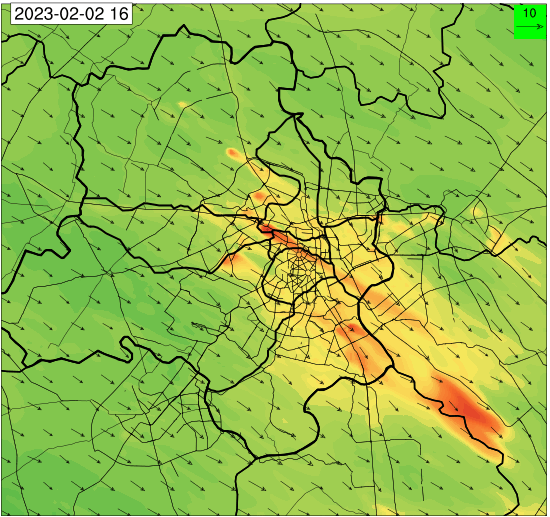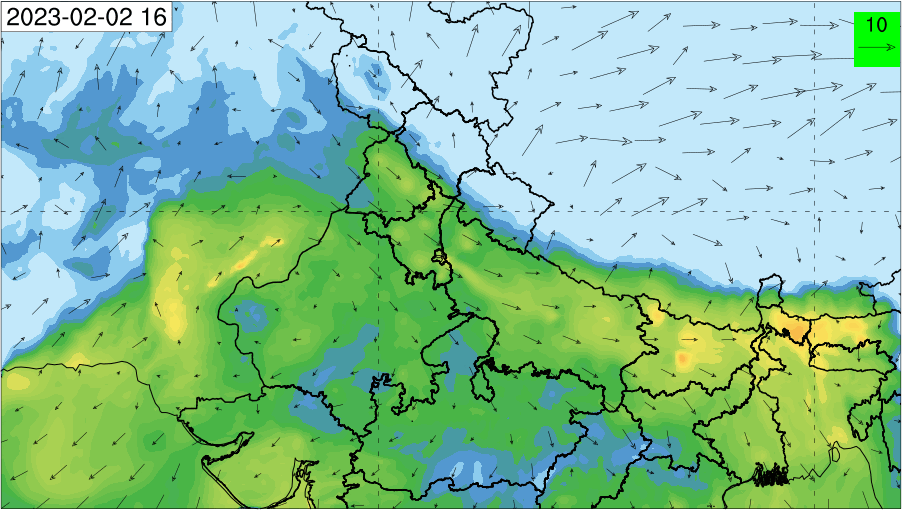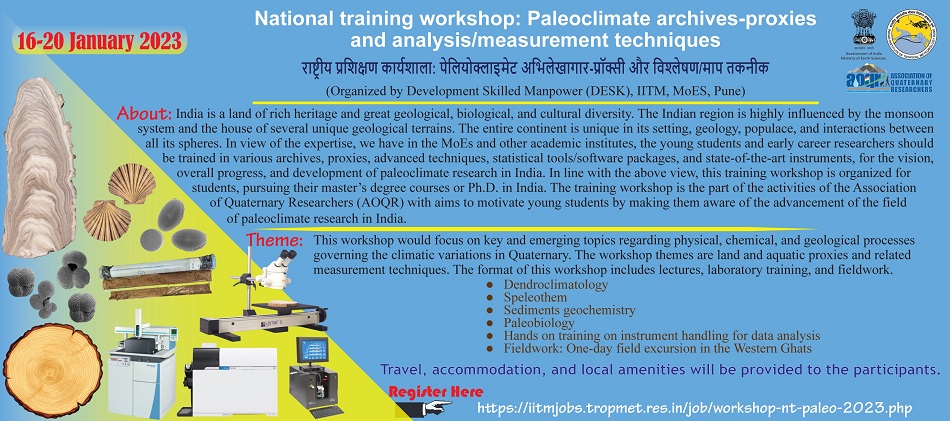Seminars / Lectures
IITM Publication Highlights
Estimation of Stratospheric Intrusions During Indian Cyclones
 Deep convection associated with tropical cyclones leads to stratosphere-troposphere exchange (STE), which affects the upper-tropospheric ozone concentrations in the vicinity of the cyclones. Using reanalysis data sets, aircraft observations, and model simulations, this study estimates the ozone enhancements over India caused by STE associated with North Indian Ocean (NIO) cyclones formed between 2007 and 2017. During the NIO cyclones, stratospheric ozone accounts for roughly 60% of the excess upper tropospheric ozone over India. Stratospheric intrusion caused by cyclones in the Bay of Bengal and the Arabian Sea affected the upper tropospheric ozone levels over North and South India, respectively. The stratospheric ozone was found to propagate downward into the troposphere, frequently reaching 600 hPa and, in some cases, the surface.
Deep convection associated with tropical cyclones leads to stratosphere-troposphere exchange (STE), which affects the upper-tropospheric ozone concentrations in the vicinity of the cyclones. Using reanalysis data sets, aircraft observations, and model simulations, this study estimates the ozone enhancements over India caused by STE associated with North Indian Ocean (NIO) cyclones formed between 2007 and 2017. During the NIO cyclones, stratospheric ozone accounts for roughly 60% of the excess upper tropospheric ozone over India. Stratospheric intrusion caused by cyclones in the Bay of Bengal and the Arabian Sea affected the upper tropospheric ozone levels over North and South India, respectively. The stratospheric ozone was found to propagate downward into the troposphere, frequently reaching 600 hPa and, in some cases, the surface.
Roy C., Ravishankara A.R., Newman P.A., David L.M., Fadnavis S., Rathod S.D., Lait L., Krishnan R., Clark H., Sauvage B., Journal of Geophysical Research: Atmospheres, 128: e2022JD037519, February 2023, DOI:10.1029/2022JD037519, 1-21
Read MoreRevised cloud processes to improve the simulation and prediction skill of Indian summer monsoon rainfall in climate forecast system model
 The study attempts to assess the seasonal prediction skill and mean monsoon features in CFSv2 with WSM6 cloud microphysics scheme (EXPT) over the Indian summer monsoon region using 34 years of model hindcast run. The results reveal that the revised version of CFSv2 (EXPT) shows relative improvement in summer monsoon precipitation, its variability, rainfall annual cycle, rainfall probability distribution function, synoptic and intraseasonal variance, etc. over ISM region compared to standard CFSv2 (CTRL). Robust representation of cloud hydrometeors in the WSM6 microphysics scheme leads to better large-scale precipitation distribution compared to CTRL simulation which resulted in realistic northward propagation of rainfall bands in the EXPT.
The study attempts to assess the seasonal prediction skill and mean monsoon features in CFSv2 with WSM6 cloud microphysics scheme (EXPT) over the Indian summer monsoon region using 34 years of model hindcast run. The results reveal that the revised version of CFSv2 (EXPT) shows relative improvement in summer monsoon precipitation, its variability, rainfall annual cycle, rainfall probability distribution function, synoptic and intraseasonal variance, etc. over ISM region compared to standard CFSv2 (CTRL). Robust representation of cloud hydrometeors in the WSM6 microphysics scheme leads to better large-scale precipitation distribution compared to CTRL simulation which resulted in realistic northward propagation of rainfall bands in the EXPT.
Phani M.K.R., Ganai M., Tirkey S., Mukhopadhyay P., Climate Dynamics, Online, January 2023, DOI:10.1007/s00382-023-06674-1, 1-22
Read MoreReview of speleothem records of the late Holocene: Indian summer monsoon variability & interplay between the solar and oceanic forcing
 The study aims to revisit the available speleothem records to study ISM rainfall variations and possible controlling factors in different Indian regions viz., core monsoon zone (CMZ), peninsular, the Himalaya, and the Bay of Bengal in the last 4000 years. The late Holocene encompasses notable global warm periods viz., Medieval Climate Anomaly, Roman Warm Period (RWP) & Minoan Warm Period, and cold periods viz., Dark Age cold period and Little Ice Age (LIA). ISM rainfall declines until the middle of RWP in all the regions. The decline is linked with the southward migration of the Intertropical convergence zone caused by the northern Hemisphere summer insolation.
The study aims to revisit the available speleothem records to study ISM rainfall variations and possible controlling factors in different Indian regions viz., core monsoon zone (CMZ), peninsular, the Himalaya, and the Bay of Bengal in the last 4000 years. The late Holocene encompasses notable global warm periods viz., Medieval Climate Anomaly, Roman Warm Period (RWP) & Minoan Warm Period, and cold periods viz., Dark Age cold period and Little Ice Age (LIA). ISM rainfall declines until the middle of RWP in all the regions. The decline is linked with the southward migration of the Intertropical convergence zone caused by the northern Hemisphere summer insolation.
Reddy A.P., Gandhi N., Krishnan R., Quaternary International, 642, December 2022, DOI:10.1016/j.quaint.2021.06.018, 41-47
Read MoreCloud radar perspective on tropical warm clouds associated with summer monsoon rainfall and warm rain onset process
 Representation of warm clouds stands a dominant source of uncertainty on climate models that prompted to characterize the macro- and micro-physical properties and diurnal variability of warm clouds. This observational study also discusses the transition of cloud droplets to raindrops in the warm clouds. High sensitive Ka-band radar serves as the best tool to capture the non-precipitating and light drizzling warm clouds and study smaller cloud droplets' growth into raindrops in the presence of turbulence. This study provides a multi-observation-based perspective on the macro- and micro-physical characteristics of monsoon warm clouds and the onset of warm rain for a better representation in the global climate models.
Representation of warm clouds stands a dominant source of uncertainty on climate models that prompted to characterize the macro- and micro-physical properties and diurnal variability of warm clouds. This observational study also discusses the transition of cloud droplets to raindrops in the warm clouds. High sensitive Ka-band radar serves as the best tool to capture the non-precipitating and light drizzling warm clouds and study smaller cloud droplets' growth into raindrops in the presence of turbulence. This study provides a multi-observation-based perspective on the macro- and micro-physical characteristics of monsoon warm clouds and the onset of warm rain for a better representation in the global climate models.
Sukanya P., Kalapureddy M.C.R., Atmospheric Research, 278: 106351, November 2022, DOI:10.1016/j.atmosres.2022.106351, 1-18
Read MoreNew Publications
Symmetric and asymmetric response of Indian Summer Monsoon rainfall to different ENSO decay phases in observations and CMIP6 models
Chowdary J.S., Saikrishna T.S., Dandi R.A., Patekar D., Parekh A., Gnanaseelan C., Osuri K.K., Symmetric and asymmetric response of Indian Summer Monsoon rainfall to different ENSO decay phases in observations and CMIP6 models, Global and Planetary Change, 220: 104000, January 2023, DOI:10.1016/j.gloplacha.2022.104000, 1-20
Chloride (HCl ∕ Cl−) dominates inorganic aerosol formation from ammonia in the Indo-Gangetic Plain during winter: modeling and comparison with observations
Pawar P.V., Ghude S.D., Govardhan G., Acharja P., Kulkarni R., Kumar R., Sinha B., Sinha V., Jena C., Gunwani P., Adhya T.K., Nemitz E., Sutton M.A., Atmospheric Chemistry and Physics, 23, January 2023, DOI:10.5194/acp-23-41-2023, 41-59
Aspects of melting layer and fall streaks in stratiform cloud system over the Western Ghats, India from Ka-band polarimetric radar observations
Das Subrata K., Deshpande S.M., MuraliKrishna U.V., Konwar M., Kolte Y.K., Chakravarty Kaustav, Kalapureddy M.C.R., Sahoo S., Atmospheric Research, 281: 106463, January 2023, DOI:10.1016/j.atmosres.2022.106463, 1-13
Impact of reduced ENSO variability and amplitude on ISMR prediction in the long-lead forecasts of monsoon mission CFS
Pillai P.A., Rao Suryachandra A., Gangadharan K.V., Pradhan M., Srivastava Ankur, Jain D.K., International Journal of Climatology, 42, December 2022, DOI:10.1002/joc.7809, 9166-9181
PDF Publisher Link











